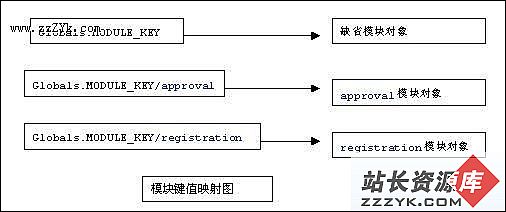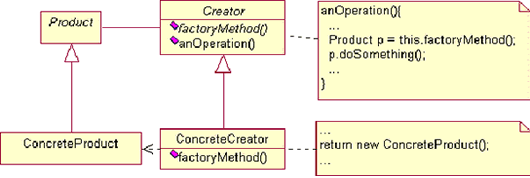当前位置:编程学习 > JSP >>
答案:4、模块定义
通过上面对STRUTS的模块化机制的讲解,我们现在可以开始实现我们的模块化例子程序了。
4.1 Actionservlet参数
我们在struts的web.xml中定义模块。下面的代码定义了三个模块:缺省模块,approval和registration模块,前缀分别是””,/approval和/registration。
<web-app>
<servlet>
<servlet-name>action</servlet-name>
<servlet-class>org.apache.struts.action.ActionServlet</servlet-class>
<init-param>
<param-name>config</param-name>
<param-value>/WEB-INF/struts-config.xml</param-value>
</init-param>
<init-param>
<param-name>config/approval</param-name>
<param-value>/WEB-INF/struts-config-approval.xml</param-value>
</init-param>
<init-param>
<param-name>config/registration</param-name>
<param-value>/WEB-INF/struts-config-registration.xml</param-value>
</init-param>
</init-param>
<load-on-startup>1</load-on-startup>
</servlet> <servlet-mapping>
<servlet-name>action</servlet-name>
<url-pattern>*.do</url-pattern>
</servlet-mapping>
</web-app>
这样在初始化actionservlet的过程中,servletcontext的属性中就会有这样的属性键/值关系:
4.2 approval模块配置文件
下面是approval模块的配置文件,定义了form和action,以及相应的forward。
<?xml version="1.0" encoding="UTF-8"?>
<!DOCTYPE struts-config PUBLIC "-//Apache Software Foundation//
DTD Struts Configuration 1.1//EN"
"http://jakarta.apache.org/struts/dtds/struts-config_1_1.dtd">
<struts-config>
<form-beans>
<form-bean name="approvalForm" type="com.i505.struts.approval.form.ApprovalForm">
</form-bean>
</form-beans>
<action-mappings>
<action
attribute="approvalForm"
name="approvalForm"
input="/index.jsp"
path="/approval"
scope="request"
type="com.i505.struts.approval.action.ApprovalAction">
<forward name="success" contextRelative="false" path="/resultok.jsp" />
</action>
</action-mappings>
</struts-config>
4.3 registration模块配置文件
下面是registration模块的配置文件,定义了form和action,以及相应的message-resources和forward。
<?xml version="1.0" encoding="UTF-8"?>
<!DOCTYPE struts-config PUBLIC "-//Apache Software Foundation//
DTD Struts Configuration 1.1//EN"
"http://jakarta.apache.org/struts/dtds/struts-config_1_1.dtd">
<struts-config>
<form-beans>
<form-bean name="registrationForm" type="com.i505.struts.registration.form.RegistrationForm" />
</form-beans>
<action-mappings>
<action
attribute="registrationForm"
input="/index.jsp"
name="registrationForm"
path="/registration"
type="com.i505.struts.registration.action.RegistrationAction">
<forward name="success" path="/resultok.jsp" />
</action>
</action-mappings>
<message-resources parameter="com.i505.struts.ApplicationResources"/>
</struts-config>
5、模块选择
本节主要讲述struts中如何选择模块,实现模块的真正运作的。
5.1 action的模块选择
当我们在浏览器中使用http://hostaddress/contextpath/module/action.do式样的的url时,actionservlet会根据module选择模块对象,下面是actionservlet处理http请求的代码:
protected void process(HttpServletRequest request,
HttpServletResponse response)
throws IOException, ServletException {
RequestUtils.selectModule(request, getServletContext());
getRequestProcessor(getModuleConfig(request)).process
(request, response);
}
&nb
- 更多JSP疑问解答:
- jsp新手求指导,不要笑!
- 如何让一个form提取的值传递给多个jsp?
- DW中,新建的html页面能否有jsp或php代码?
- jsp 如何限制表单,实现只能填写特定的数据。
- jsp 和javabean结合的程序有问题
- 从数据库里取出的数据如何传递到另外的jsp页面中
- 你好,ext嵌入那个jsp页面,是不是还需要加上一些插件啊,不太懂,麻烦你了。
- JSP不能处理所有问题吗?还要来一大堆的TLD,TAG,XML。为JSP 非要 Servlet 不可吗?
- 光标离开时全角转半角在jsp中怎么实现
- jsp 页面 打开 pdf 文件 控制大小 和 工具栏 能发份源码么 谢啦
- jsp页面点保存按钮,运行缓慢,弹出对话框提示
- jsp刷新页面如何不闪屏
- jsp 与html 的交互问题?
- jsp小数显示问题 例如 我在oracle 数据库中查询出来的是 0.01 但是在jsp页面上就显示成 .01 没有前面的0
- jsp中日历控件






